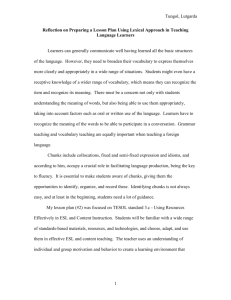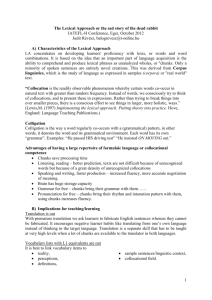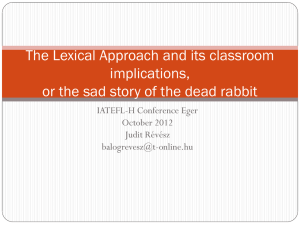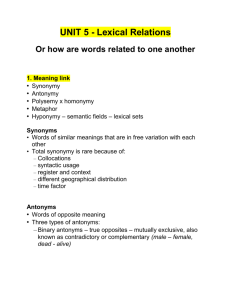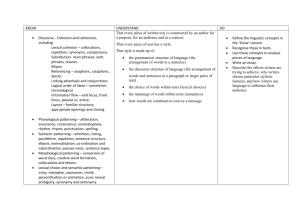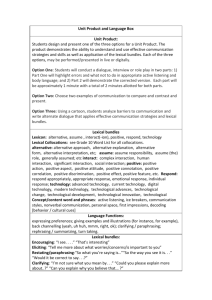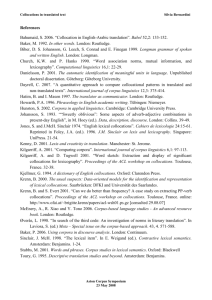Lexical Approach Handout
advertisement
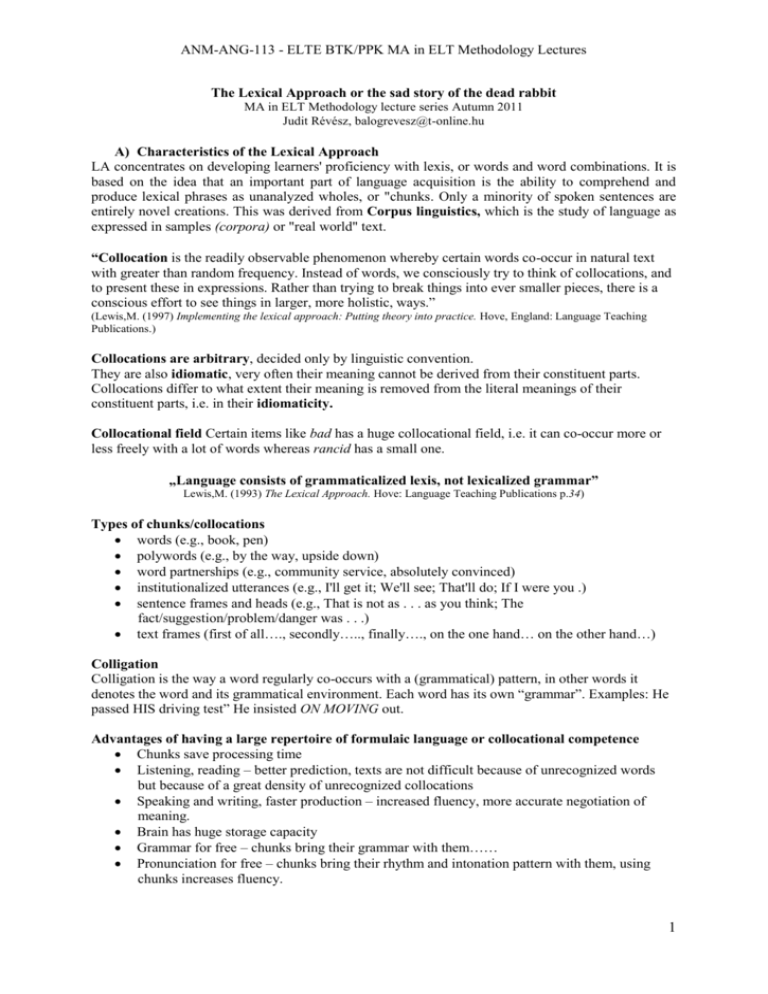
ANM-ANG-113 - ELTE BTK/PPK MA in ELT Methodology Lectures The Lexical Approach or the sad story of the dead rabbit MA in ELT Methodology lecture series Autumn 2011 Judit Révész, balogrevesz@t-online.hu A) Characteristics of the Lexical Approach LA concentrates on developing learners' proficiency with lexis, or words and word combinations. It is based on the idea that an important part of language acquisition is the ability to comprehend and produce lexical phrases as unanalyzed wholes, or "chunks. Only a minority of spoken sentences are entirely novel creations. This was derived from Corpus linguistics, which is the study of language as expressed in samples (corpora) or "real world" text. “Collocation is the readily observable phenomenon whereby certain words co-occur in natural text with greater than random frequency. Instead of words, we consciously try to think of collocations, and to present these in expressions. Rather than trying to break things into ever smaller pieces, there is a conscious effort to see things in larger, more holistic, ways.” (Lewis,M. (1997) Implementing the lexical approach: Putting theory into practice. Hove, England: Language Teaching Publications.) Collocations are arbitrary, decided only by linguistic convention. They are also idiomatic, very often their meaning cannot be derived from their constituent parts. Collocations differ to what extent their meaning is removed from the literal meanings of their constituent parts, i.e. in their idiomaticity. Collocational field Certain items like bad has a huge collocational field, i.e. it can co-occur more or less freely with a lot of words whereas rancid has a small one. „Language consists of grammaticalized lexis, not lexicalized grammar” Lewis,M. (1993) The Lexical Approach. Hove: Language Teaching Publications p.34) Types of chunks/collocations words (e.g., book, pen) polywords (e.g., by the way, upside down) word partnerships (e.g., community service, absolutely convinced) institutionalized utterances (e.g., I'll get it; We'll see; That'll do; If I were you .) sentence frames and heads (e.g., That is not as . . . as you think; The fact/suggestion/problem/danger was . . .) text frames (first of all…., secondly….., finally…., on the one hand… on the other hand…) Colligation Colligation is the way a word regularly co-occurs with a (grammatical) pattern, in other words it denotes the word and its grammatical environment. Each word has its own “grammar”. Examples: He passed HIS driving test” He insisted ON MOVING out. Advantages of having a large repertoire of formulaic language or collocational competence Chunks save processing time Listening, reading – better prediction, texts are not difficult because of unrecognized words but because of a great density of unrecognized collocations Speaking and writing, faster production – increased fluency, more accurate negotiation of meaning. Brain has huge storage capacity Grammar for free – chunks bring their grammar with them…… Pronunciation for free – chunks bring their rhythm and intonation pattern with them, using chunks increases fluency. 1 ANM-ANG-113 - ELTE BTK/PPK MA in ELT Methodology Lectures B) Implications for teaching/learning Translation is out With premature translation we ask learners to fabricate English sentences whereas they cannot be fabricated. It encourages negative learner habits like translating from one’s own language instead of thinking in the target language. Translation is a separate skill that has to be taught at very high levels when a lot of chunks are available to the translator in both languages. Vocabulary lists with L1 equivalents are out It is best to link vocabulary items to reality, sample sentences/linguistic context, perceptions, collocational field. definitions, Monolingual dictionaries should be introduced gradually but as early as possible, the process should start at pre-intermediate level. Creativity is highly overrated Learner creativity is not rewarded at exams. Although collocations change very fast, they are controlled by the native speaker community. Learner creativity should start at the level of combining chunks. Rote learning is back Fluent language use requires a large amount of over-learnt chunks. Collocations memory, jigsaw Copying – off-the wall-dictation Gapped reading Drills Correcting text Learning by heart, songs, poetry, tongue Reconstructing text twisters, proverbs, etc. Dictation Huge amounts of input Intensive and extensive listening and reading in the target language so that chunks re-appear in various linguistic and social contexts and therefore are re-enforced. Raising awareness Noticing and recording language patterns and collocations Observe-Hypothesize-Experiment, as opposed to the traditional Present-Practice-Produce paradigm. Working with language corpuses, collocation dictionaries, etc. British National Corpus C) Criticism St output is undervalued (RJ) There is no methodology or syllabus (Thornbury) Learning time is limited, grammatical structures are often generative (Swan) Decisions about which collocations to include at which level are difficult. Accuracy is back in a more wicked way. Compulsory reading: Lewis, M. (2000) Language in the Lexical Approach, In: Teaching Collocation, Further Developments in the Lexical Approach. Hove: Language Teaching Publications. Chapter 7, pp 126-155. Recommended reading Nattinger, R. J., DeCarrico, J. S. (1992), Lexical Phrases and Language Teaching. Oxford: Oxford University Press Harwood, N. (2001) Taking a lexical approach to teaching: principles and problems Talk delivered at 35th IATEFL conference. http://privatewww.essex.ac.uk/~nharwood/lexapproach.htm Thornbury, S. (1998) The Lexical Approach: A Journey without Maps? Modern English Teacher, Vol.7. No.4. http://www.thornburyscott.com/assets/Lexical%20approach.pdf Swan, M. (2006) Chunks in the classroom: let’s not go overboard. The Teacher Trainer. 20/3, 2006 retrieved at http://www.mikeswan.co.uk/elt-applied-linguistics/chunks-in-the-classroom.htm 2
